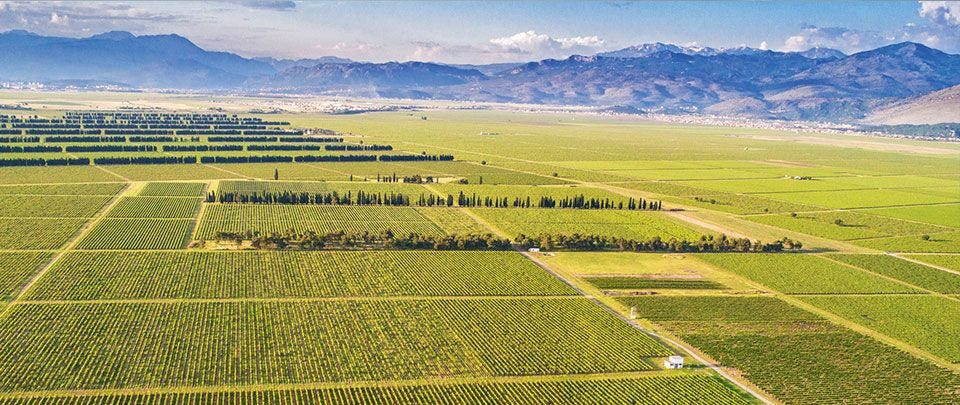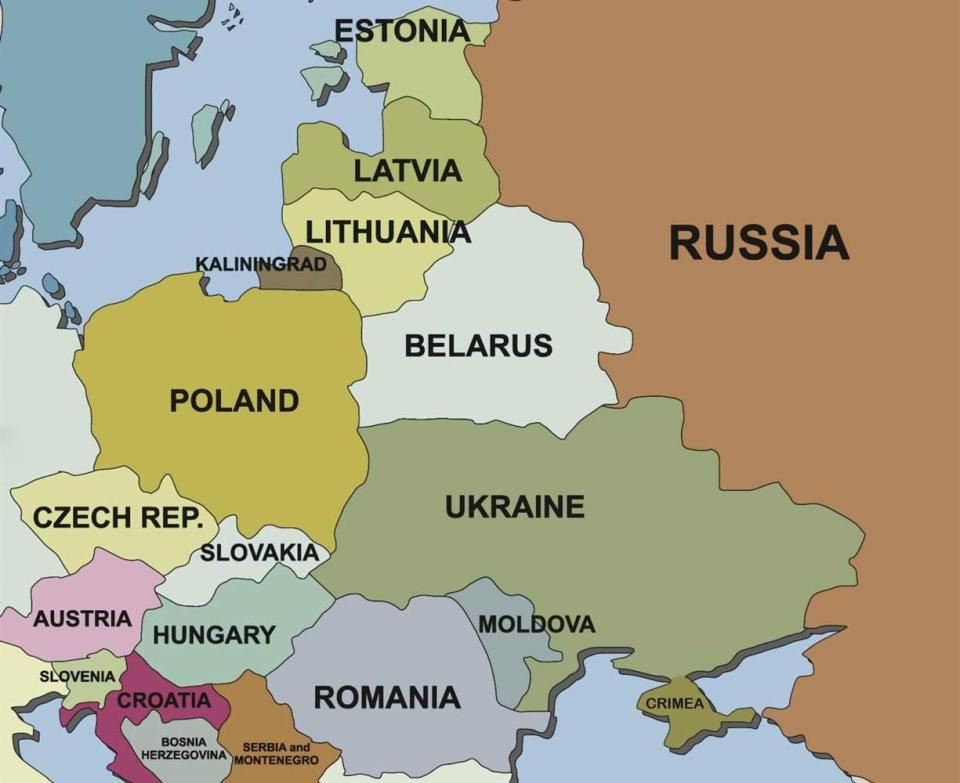Montenegro - testing ground for a Russian tactic?
A recipe for a chickpea flour loaf and Kačamak, a Montenegrin polenta
In its war with Ukraine, Russia is blockading exports to the 400 million people worldwide that Ukraine normally supplies with grain and the sunflower seeds that provide cooking oil.
This is not the first time Russia has used provisions as weapons.
Travelling in 2019 round the little-known jewel that is Montenegro, one of the most jaw-dropping views was not the one below, but the 11.5 million grapevines seen from the plane, growing in clean lines across 2,310 hectares of land just 15 minutes south of the capital Podgorica.
Every year, the partly state-owned Plantaže winery produces nearly 17 million litres of wine. ‘Pumps out’ would be unfairly derogatory since it takes pride in not making wines in bulk.
It’s the largest single-plot vineyard in Europe, larger in area, even, than Montenegro’s capital city. Those with a knowledge of wine say its reds are reminiscent of a Primitivo from Puglia, or a California Zinfandel. 70 percent of the vineyard’s grapes are an ancient Montenegrin variety called Vranac, hand-picked by 2000 people. Just take a minute to picture the size of that endeavour. The Vranac varietal involves names it’s a shame can’t be used on the Scrabble board. It originates in Crmnica, from Montenegro’s oldest variety Kratošija and the rare Duljengaand.
Part of Yugoslavia from 1918, Montenegro like neighbouring Serbia has had strong cultural and linguistic roots with Russia. It’s a popular holiday destination for wealthy Russians who have already made a trip to London with empty suitcases and a realty contract, and a visit to the Plantaže winery is a hot TripAdvisor outing. Montenegro exported its wines to over 40 different countries including Russia, which imported 20 percent of the country’s wine output.
The Plantaže winery has three cellars, the main one of which is a massive underground space, 356 metres long. (The Empire State Building is 380 metres high.) It used to be a hangar for ex-Yugoslavia fighter planes, housing 38 of them - Migs, Sokos, Antonovs and more. During the Kosovo war in 1999, the hangar was partly destroyed by NATO bombs. In 2007, after Montenegro declared independence from Serbia, the hangar was restored, and transformed into an immense wine cellar.
Ten years later, on 28 April 2017, Montenegro’s parliament defied Moscow and ratified the nation’s application for membership of NATO. Moscow had been vehemently asserting that such a union would run counter to hundreds of years of "fraternal relations" “between two Slavic, Orthodox Christian nations”. (Heard that line recently? Russians have, repeatedly, in news bulletins on Russia's anti-Ukraine state media.) A 2016 alleged attempt at a coup d’etat had been blamed by Montenegrins on Moscow as a move to undermine their NATO application and indictment proceedings launched against 14 people including two Russians and two pro-Russian leaders charged with plotting to overthrow the Podgorica government.
But on 26 April, two days prior to parliament’s ratification of that NATO application, Russia's consumer rights and protection agency, Rospotrebnadzor, announced it was banning all imports of Plantaže wine because of elevated pesticide and plastic particle levels in some vintages.
The 15,500 bottles already in Russia were pulled off shelves, followed in May by a further 16,200 bottles. This despite four independent international laboratories establishing no evidence of any taint.
In 2013, when Ukraine’s small neighbour Moldova, the darker blue sliver on the map above sandwiched next to Romania, launched a drive to join the European Union, Moscow banned all imports of that ex-Soviet republic’s wines and spirits, claiming they, too, contained impurities. Only on 5 May of this year, as a consequence of Moldova’s acceptance of more than 450,000 Ukrainian refugees (UK, take note), did the EU Parliament welcome its EU membership application.
It is possible to live without wines and spirits, albeit sad. But other comestibles are essential. Together, Russia and Ukraine are responsible for 28 percent of the world’s supply of wheat (up in price 59 percent since the start of the year), 29 percent of barley, 15 percent of maize. Not immediately significant numbers? How about this: they supply 75 percent of the world’s supply of sunflower oil. That’s your bottled mayo, all your take-out fries and other fry-ups. Without sunflower oil, how will high streets’ fast food outlets bring you their fish-and-chips, their burgers-and-fries, spring rolls, wontons, their ethnic specialities? How will you produce your own home-cooked meals without sunflower oil in your kitchen arsenal? And that’s the foodstuffs of the relatively comfortable consumer.
Russia’s war is deliberately preventing essential global food supplies from leaving Ukraine. Already the number of people globally facing food poverty has risen from 440 million to 1.6 billion. Nearly 250 million are on the brink of famine. If the war continues, hundreds of million more will struggle to find enough - or any - food.
Once upon a time, weaponry centred upon horrific arms of a terrifying nature. Those haven’t gone away. But add to them now the weaponization of…food.
So far, water isn’t on the list. Just wait. Increasing droughts suggest it’s inevitable.
Our own battleground must be to insist on food security. And on support for our local farmers and producers to keep them in the business of providing us with our healthy food. And on assistance for families and social institutions in need of help, everywhere.
In place of wheat flour, here is a quickly-made loaf using chickpea flour, also known as gram flour, besan or garbanzo flour, which needs no proving time and is gluten free.
300g/2½ cups chickpea flour
1½ tablespoons sugar
1¼ teaspoons baking soda
1/4 teaspoon fine sea salt
355 ml/12 fl oz soda or seltzer water
2 tablespoons olive oil
Preheat oven to 190/375F. Line a 22.5x12.5cm/9x5 in loaf tin with greased parchment paper.
In a large bowl, whisk together the first four ingredients.
Slowly pour the soda water down the side of the bowl to prevent it foaming. Stir in the olive oil then pour into the loaf tin.
Bake in the preheated oven for 40 to 45 minutes until risen, golden brown and a skewer comes out clean.
Cool in the pan on a wire rack for 15 minutes then remove from the tin. Cool completely before slicing.
But for a Montenegrin experience, try Kačamak. It’s is a wholesome Montenegrin corn dish, commonly eaten at breakfast, that would make an alternative to the more famiar Italian polenta. In Montenegro, it is served warm, with sour cream or sauerkraut.
Serves 4-6
1 kg/2.2 lbs potatoes
600g/1.3 lbs coarse cornmeal or polenta
250g/9 oz kaimak, a clotted cream available at Middle East markets. Mascarpone can substitute
300g/10½ oz fresh cheese (in Montenegro, this would be a hard sheep’s cheese. Parmesan will substitute)
about 2 litres/3½ pints water
1 tablespoon salt
Peel and quarter the potatoes and boil in plentiful salted water for 30 minutes. When they are almost mushy, remove 190ml/6¾ fluid ounces of water and pour in the corn meal into a cone shape. Don’t mix it but make a wide hole with the handle of a wooden spoon for steam to escape, and cook on low heat uncovered for 20 minutes. Beat the mixture together with a wooden spoon to fully incorporate the two ingredients, 10-15 minutes. In a separate pan, gently heat together the cream and the grated cheese over a low heat then pour it over the potatoes-and-flour mixture. Stir to incorporate well for several minutes. Serve warm.










I always learn something from this beautiful writer and remarkable cook. Thank you yet again Julia.
A great read with all the right emphasis and facts. Just one addition: Russia banned import of Georgian wine and mineral water back in 2006 for almost the same reasons. So, the history of Russia's use of food as weapon goes way back than 2013 or 2016